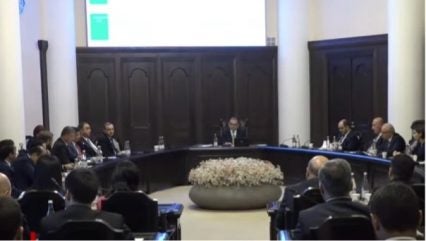
In order to manage plans for the construction of a new nuclear power unit in Armenia, the government has decided to set up a closed joint-stock company. The Minister of Territorial Administration & Infrastructure, Gnel Sanosyan, noted in his speech, that the new company will be called “Construction of a new nuclear power unit”. It is planned to replace the capacities unit 2 at the Armenian NPP by 2040. The government is also considering the construction of a small modular reactor (SMR) or reactors is this is deemed economically feasible.
The proposed closed joint-stock company must comply with International Atomic Energy Agency (IAEA) standards with respect to its organisation and selection of personnel and funding will be provided from the state budget. It will report to the Ministry of Territorial Administration & Infrastructure.
The new company will undertake a comparative study of all the proposed technologies and feasibility studies, on the basis of which it will it will propose a technology for the plant. After the proposal is approved by the government, the company will have to negotiate and prepare documents related to construction, financing, ownership and operation the nuclear power unit or units following the adoption of legislation authorising construction.
The company will be project manager for the new unit and subsequently its operator, and will be staffed with appropriate personnel. According to rough estimates, at the preparatory stage in 2024, some AMD800m ($2m) will be allocated for the establishment and operation of the company, with a further AMD800m allocated each year subsequently. According the the IAEA such a project requires a staff of 50-60 highly qualified specialists from various fields (electricity, nuclear physics, environmental protection, education, urban development, etc.).
“We believe that after the creation of this organisation and the recruitment of appropriate personnel, within 1.5-2 years it will be able to issue a reasonable proposal to the government regarding the choice of technology,” said Sanosyan. “It should be noted that all countries building new nuclear power units … have followed this path.”
As the new unit will require a reference plant, the authorities noted that SMR projects in the design of licensing stage will be considered only “on paper”. While Russia is offering a new power unit of 1000-1200 MWe, which has already been tested in many countries this may not be appropriate for Armenia’s energy system, the installed capacity of which is only 1,000 MWe. However, Rosatom First Deputy General Director Kirill Komarov recently suggested that Russia could build a nuclear reactor of any capacity between 50 MWe and 1000 MWe, using separate units of 50 MWe each.
Meanwhile work continues to extend the operating life of the existing NPP until 2036 for which the government has allocated $65m. The authorities say a new nuclear unit must be in place by then. The extension work is being undertaken by Rosatom.
The currently operating Armenian NPP at Metsamor was built in the 1970s with two Soviet-supplied VVER-440-V230 units, but was closed following a devastating earthquake in 1988. However, unit 2 was recommissioned with Russian help in 1995 following severe energy shortages. In March 2014, the Armenian government decided to extend the plant’s service life to 2026.
In November 2021, it was announced that the service life of Metsamor 2 had been extended to 2026 after collaboration with Rosatom. The modernisation was mostly implemented under a loan agreement signed between Armenia and Russia in 2015. However, in 2020, the Armenian government decided to provide a loan worth AMD 63.2bn from the state budget for the work, noting that it would use only 60% of a $270m Russian loan intended to finance the modernisation.
In June 2023, Armenian Prime Minister Nikol Pashinian set up a working group tasked with exploring various options for building the new facility, including SMRs, and submit its findings to the prime minister’s staff and in January 2024, Pashinian said Armenia planned to build a new NPP within 8-10 years. He noted that various options were being investigated, including technologies from Russia, the USA, and South Korea.






